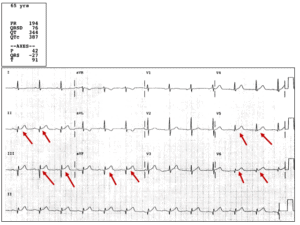Published on
Differential Diagnosis
First-degree AV block
Supraventricular tachycardia
Inferior lateral STEMI
Wolff-Parkinson-White syndrome
Brugada syndrome

Diagnosis
This patient was diagnosed with inferior lateral STEMI.
The normal PR interval is 120 to 200 ms; this PR interval is 194, so it would not be first-degree AV block.
Supraventricular tachycardia is a narrow complex tachycardia with a heart rate over 100 bpm; the rate here is 76, so this is not SVT.
Wolff-Parkinson-White would have three findings including a widened QRS (>120ms), short PR (<120ms), and a Delta wave; none of these findings are present.
Brugada syndrome is diagnosed when leads V1 and V2 show ST elevation with an R R’ phenomena. This is not present, either.
This ECG does show ST elevation in the interior leads, which are leads II, III, and aVF, as well as showing elevation in some of the lateral leads, namely V5 and V6. This is an acute inferior lateral STEMI.
Learnings/What to Look for
- Symptoms predictive of myocardial infarction often include
- Exertional chest pain
- Diaphoresis
- Dyspnea
- Pain similar to symptoms present during a past MI
- Atypical symptoms may include fatigue, confusion, or neck/arm/jaw pain
- Diabetic patients, the elderly, and women may present atypically
- This patient initially attributed his symptoms to heartburn, a common occurrence with inferior MI
- Inferior STEMIs are typically due to an occlusion in the right coronary artery (RCA)
Pearls for Urgent Care Management and Considerations for Transfer
- All patients with STEMI require emergent transfer to the emergency department via EMS
- Acute inferior lateral STEMIs are high risk, as the occluded vessel may also result in infarction of the right ventricle and resultant hypotension. Place two large-bore IVs while waiting for EMS to arrive
- Do not administer SL NTG to patients with an inferior STEMI, as this may result in severe hypotension
- Consider oxygen if hypoxemic and place on a cardiac monitor while awaiting transport
- Have patient chew an aspirin 81-325 mg while awaiting transport
